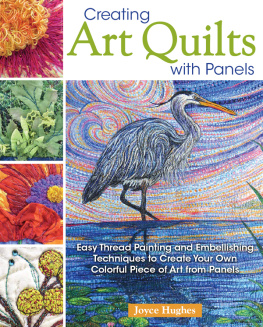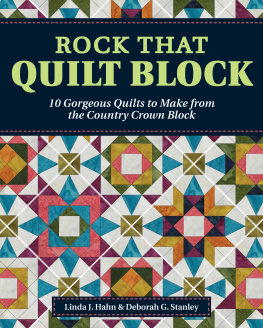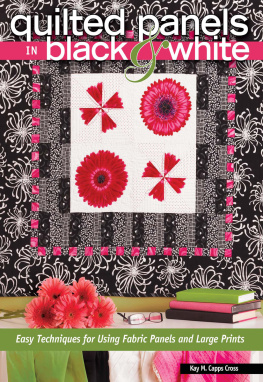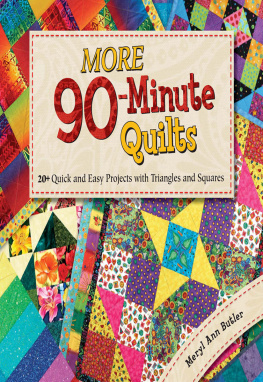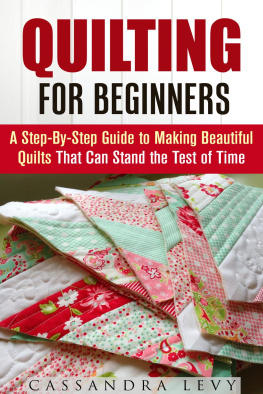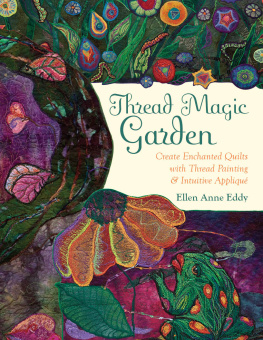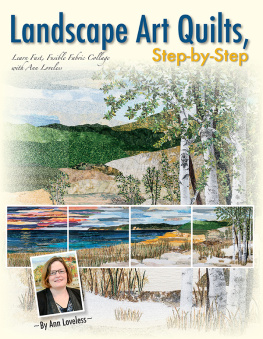Contents
Guide

Dedication
To Kyle, thank you for believing in me and seeing my talents before I saw them for myself. You encouraged me to show people my quilts, and now people can see them and make their own quilts through this book. Your loving soul will continue to grow...
Creating Art Quilts with Panels
Landauer Publishing is an imprint of Fox Chapel Publishing Company, Inc.
Copyright 2019 by Joyce Hughes and Fox Chapel Publishing Company, Inc., 903 Square Street, Mount Joy, PA 17552.
All rights reserved. No part of this book may be reproduced, stored in a retrieval system, or transmitted in any form or by any means, electronic, mechanical, photocopying, recording, or otherwise, without the prior written permission of Fox Chapel Publishing, except for the inclusion of brief quotations in an acknowledged review and the enlargement of the template patterns in this book for personal use only. The patterns themselves, however, are not to be duplicated for resale or distribution under any circumstances. Any such copying is a violation of copyright law.
Vice PresidentContent: Christopher Reggio; Editor: Colleen Dorsey; Copy Editor: Anthony Regolino; Designer: Wendy Reynolds; Photographers: Joyce Hughes and Sue Voegtlin; Indexer: Jay Kreider
Images of complete panels on (left and middle) graciously provided with permission by Northcott Silk Inc.
Shutterstock photos: (bottom right): wasanajai
Print ISBN 978-1-947163-16-4
eISBN 978-1-60765-689-0
Library of Congress Cataloging-in-Publication Data
Names: Hughes, Joyce, 1961- author.
Title: Creating art quilts with panels / Joyce Hughes.
Description: Mount Joy, PA : Landauer Publishing is an imprint of Fox Chapel
Publishing Company, Inc., [2019] | Includes index.
Identifiers: LCCN 2018038110 (print) | LCCN 2018038695 (ebook) | ISBN 9781607656890 () | ISBN 9781947163164 (softcover)
Subjects: LCSH: Quilting--Patterns. | Appliqu--Patterns. | Art quilts. Classification: LCC TT835 (ebook) | LCC TT835 .H815 2019 (print) | DDC 746.46/041--dc23
LC record available at https://lccn.loc.gov/2018038110
We are always looking for talented authors. To submit an idea, please send a brief inquiry to .
This book has been published with the intent to provide accurate and authoritative information in regard to the subject matter within. While every precaution has been taken in the preparation of this book, the author and publisher expressly disclaim any responsibility for any errors, omissions, or adverse effects arising from the use or application of the information contained herein.

Contents

Acknowledgments
Thanks to:
My husband, John, my daughter, Emily, and my mom: Your encouragement and support have made me the woman and artist that I am today. I love sharing every moment of this journey with you. I love you more each day!
My personal editor, but more importantly, my dear friend, Nancy Wilkinson: Thank you for pre-editing and the fine critique of dashes, indents, and asterisks!
Debbie Byrne, staff, and students at Byrne Sewing Connection: You have listened and guided me through all my ups and downs; I would not want to share this sewing journey with anyone else.
The Longstreth Moms: Who would have thought a T-shirt quilt would have led to this
Many store owners, staff, and students: I love how our relationship has grown into a wonderful friendship.
The generosity and support from Brother USA, Mettler Threads, Northcott Fabrics, and Timeless Treasures Fabrics: Your products make my quilts shine!
My family and friends: Thank you for your love and support.

Introduction
As a child, I always loved to color. The greatest gifts I would receive were a new coloring book and a big box of crayons. But sewing is a different story. I never enjoyed sewing when I was younger. I always had trouble with the machine, birds nests in my bobbins, and broken needles. So when I started sewing many decades later, my mother was shocked and puzzled as to why I would I want to start sewing.
Soon after I started to sew, I discovered many different colors and types of threads. I was so excited to just play! I could see the changes on the fabric when I layered the threads, added metallic threads, did bobbin work, and added embellishments. My head spun with ideas, and soon I was hooked. Now I can truly say that I love playing with threads and I love sewing, especially creating quilts with thread painting and embellishments.
Shortly after I started sewing, I was asked to teach my techniques. When I first started teaching, I would design a pattern for the class. The students would trace the design, then thread paint the project. I quickly found out that people work at different speeds and that my students were at many different stages during the class. To keep everyone together during class and save time with designing, I started to work with panels. I began to look at panels with a different eye. What can I do with them? What can I change or add? Can I teach different techniques on a specific panel? Many of the answers were yes and produced amazing results. I love how a panel no longer looks like a panel but rather a true piece of art!
My hope and purpose with this book is that you, the reader, will have the same excitement and wonderful results as I do. Try the techniques covered in this book and add your own ideas to a panel. New panels are designed every year, so try these ideas and techniques on ones that are similar to those featured in this book or, even better, mix it up and create something new and different. Create your own piece of art!
CHAPTER 1
PANELS
Why Use Panels?
When I first started to teach art quilt classes, I would design a pattern and students would trace, cut, and copy my designs. Students would then learn the numerous techniques that were used on the project. This turned out to be very time-consuming. Many of my students were at different steps during the class, causing delays, pressure to catch up with others, and sometimes frustration with the creative process itself. I would hear many students saying things like, I am not creative, I do not know how to design, I am not sure what colors to use, and Am I using the correct proportion and size of items?
I needed a way to keep everyone in sync and allow my students to enjoy the whole learning and creating process. I wanted them to not be intimidated by the process and to be less critical of themselves as artists. So I started to look at premade panels for teaching. Panels soon became a great tool for me to teach many of my ideas and techniques while minimizing frustration for my students.
The main advantage of using a panel is that the designing process is done for you. There are many wonderful panels on the market today, and the designers talent and knowledge of size, shape, proportion, and color are already incorporated into each panel, allowing you to save time and skip the sometimes frustrating designing steps. This will allow you to jump right into the fun part: choosing the techniques you will use to create your own unique piece of art.

